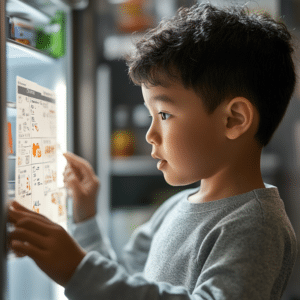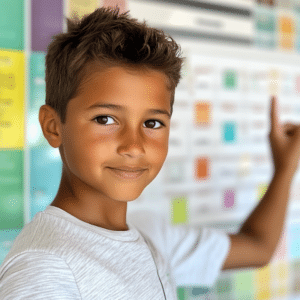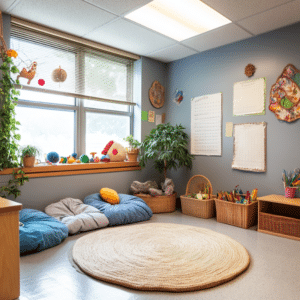Back-to-school success for neurodiverse kids starts before day one. I’ll never forget standing in my son’s new classroom three years ago, watching him scan the room with wide eyes. He clutched his favorite Ipad and whispered, “Do you think my teacher will remember I need quiet time?”
That moment crystallized what back-to-school success for neurodiverse kids really means: it’s not just about new supplies. It’s about making sure your child’s individual needs are seen, respected, and supported from day one.
If you're staring at a pile of IEP forms while buying notebooks, I'm with you too. Here’s what I’ve learned over the past 17 years years of trial, error, and growth. So I can share with you how to start your child’s school year starts with strength, not stress.

The biggest shift for our family? Realizing success starts in August—not September. While other families are shopping for backpacks, I’m scheduling meetings and practicing routines. It’s the difference between steeping into the school year prepared vs. leaving your child vulnerable.
🔹 Secure Your IEP/504 Meeting Early
As soon as school assignments drop, I email the special education coordinator. It’s a short, clear message requesting an annual review before school starts. Starting with a plan in place reduces confusion for teachers and kids.
🔹 Create a Back-to-School Command Center
No more hunting for paperwork on the kitchen counter. A simple color-coded system—blue for medical, green for IEPs, yellow for general forms—saves time and sanity. Since I have several children with IEP's I have binders with all of their paperwork. You can learn how to create a binder yourself listen to this podcast episode purchase the templates here.

🔹 Practice Routines One Week Early
Neurodiverse kids thrive on "schedules". We “rehearse” the school week before it begins—wake-up times, breakfast, getting dressed. It reduces anxiety and builds confidence. If possible contact your child's teacher or special education coordinator and ask if you can walk your child through their classroom or schedule (older children). Even if you took your child to Open House visiting the school a week before classes start is helpful for your child to feel comfortable with being in a new environment.
📊 Did you know? 76% of kids with ADHD or autism experience heightened anxiety during transitions. Practicing routines in advance reduces cortisol spikes and improves behavior on the first day of school. (Source: CHADD.org, Autism Speaks)
Mornings used to be so crazy. Between getting the kids together while answering a million and one questions because my boys are worried. Oh, and frustrations with them not liking what I put in their lunch. Now? We’ve built a system that supports both structure and flexibility.
🔹 The Night-Before Setup
Everything from socks to lunchboxes is handled the night before. Get your child involved by having them help with choosing clothes, checking their backpack, and talk about what they want for lunch. It reduces morning decision fatigue and prevents last-minute chaos. Talk to your child about what to expect the first day of school.
🔹 Visual Checklists That Empower
We use picture-based routines—even though my kids can read—because images process faster under stress. A dry-erase checklist gives my son a sense of control. For more tips about creating visual schedules checkout " Empower Your Child's Back to School Transition.

🔹 Emergency Reset Button: Music
When mornings get crazy, when my kids were younger we would blast our family “reset song” and sing it out. Now that my boys are older we play our family playlist or I ask them which song are they listening to that makes them feel good.

📊 Research shows music and movement can reduce behavioral incidents by 40% when used as a transitional tool for neurodiverse children. (Journal of Music Therapy, 2022)

One of my "Ah ha " moments s as a parent came during my son's first-grade year. He was running out of his classroom every other day. He was overwhelmed with the loud classroom and people would try to find his brother's classroom on another floor. When I asked for a quiet space for sensory breaks, his teacher replied, “What’s a sensory break?”
I was shocked because "sensory breaks" was listed in his IEP as one of his accommodations.
I explained that a short break in a calm space could help him reset before escalation. The teacher listed and spoke to the OT, and by the following week, they created a reset zone in the library.
By December, three other children were using it daily. Advocacy doesn’t just help your child—it opens doors for others too.
To get more tips about affectively communicating with your child's teacher checkout the podcast episode: Top Tips for Parents: Communicating with Schools Effectively
🗣️ Pro tip: Teachers often want practical strategies. Share clear, bite-sized info that’s helpful, not overwhelming. To ensure back to school success for neurodiverse kids.
The funny thing is even though the summer is only 2 to 3 months. The summer time is the break that our whole family needs. We get to sleep in, have a heavy schedule of therapy and tutoring, and most importantly we get to rest our brains. We are on VACATION. This why it feels like you're starting over sometimes when the new school year starts again. Ut can take a monite to het back in the groove to back-to-school success for neurodiverse kids.
🔹 Morning Emotional Check-Ins
Before school, we ask:
“How’s your energy today?”
“What might be tricky?”
“What are you excited about?”
It takes two minutes, builds emotional literacy, and reinforces that we’re on the same team.

🔹 Teacher Intro Emails That Actually Work
Before school starts, I send an introductory email that shares my childs diagnosis, strengths, challenges, and how to support them in the classroom.
“Hi, I’m Zavier’s mom. He does best with advance notice of transitions and periodic check-ins during group work.”
Teachers thank me every year. It saves them guesswork and shows we’re partners.
🔹 Celebrate the Small Stuff
Victories like asking for help, making it through a fire drill, or using a calming strategy? We celebrate every one. Progress in neurodivergent children often looks like subtle shifts—and they deserve recognition.

📊 Students with consistent parent-teacher communication are 50% more likely to see improved academic outcomes and social skills. (Harvard Family Research Project)

Last month, my son had a complete meltdown in the school pickup line. A routine had changed. He panicked. I panicked.
But here’s what was different:
Progress isn’t always loud. Sometimes it’s shorter meltdowns, better communication, or a single teacher who gets your child.
This school year won’t be perfect. There will be forgotten lunch boxes, misunderstood IEP goals, and days that feel too heavy.
You've been here before , every school year you get to build on every win, every connection, and every strategy you’ve tried. Creating back-to-school success for neurodiverse kids.
Your child’s needs are valid.
Your voice as a parent matters.
And asking for support isn’t being difficult—it’s being a advocate.
Take it one step at a time. And remember: your advocacy changes everything.
🎧 Want more real-talk tips?
Check out The Parenting Cipher Podcast—because sometimes we just need to hear: You’re not alone.